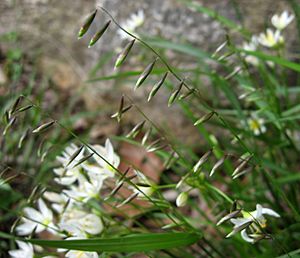Twoflower melicgrass facts for kids
Quick facts for kids Twoflower melicgrass |
|
|---|---|
 |
|
| Maturing florets | |
| Scientific classification | |
| Genus: |
Melica
|
| Species: |
mutica
|
Melica mutica, also known as the twoflower melicgrass, is a type of grass. It belongs to the Poaceae family, which is the scientific name for grasses. You can find this grass growing naturally in the southeastern part of the United States.
What is Twoflower Melicgrass?
This grass is a perennial plant. This means it lives for more than two years. It grows in clumps and has long underground stems called rhizomes. These rhizomes help the plant spread.
How Does It Look?
The main stems of the grass, called culms, can grow from 45 to 100 centimeters long. That's about 1.5 to 3.3 feet tall. The leaves have sheaths that wrap around the stem. These sheaths are like tubes and feel a bit rough.
The leaf blades themselves can be flat or folded. They are usually 2 to 6 millimeters wide. The bottom of the leaves can be smooth or slightly rough. They might also be hairless or have fine hairs.
Flowers and Seeds
The flowers of the twoflower melicgrass grow in a loose cluster called a panicle. This panicle is shaped like a spearhead and can be 4 to 16 centimeters long. The branches of the panicle spread out widely.
The small flower clusters, called spikelets, hang down. They are shaped like a wedge and are 7 to 11 millimeters long. Each fertile spikelet has two tiny flowers, called florets, at its tip. The outer parts of the florets, called lemmas, have ridges and a rough bottom.
The plant's glumes are wide and low. Both the lower and upper glumes are oblong and measure 6 to 9 millimeters long. The flowers themselves are fleshy and oblong. They have three anthers, which are about 3 millimeters long.
After flowering, the plant produces fruits. These fruits are a type of seed called caryopses. They are 2 to 3 millimeters long and have an extra outer layer.

